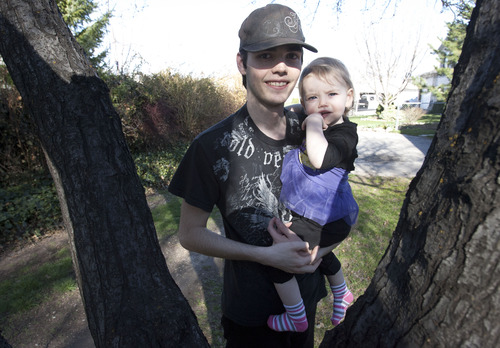This is an archived article that was published on sltrib.com in 2013, and information in the article may be outdated. It is provided only for personal research purposes and may not be reprinted.
Eric and Brianna Jeppson of West Valley City both work and say that finding child care for their 17-month-old daughter, Serenity, was difficult — and expensive. So they had to be creative.
"We looked into day care," Eric says, "but they charged $75 to $100 a day. That's most of my paycheck" as a food service worker, and his wife works for a house cleaning service.
They tried to arrange work schedules so one of them could usually be home with the baby, but it didn't work well. Then they turned to family.
"My sister-in-law has three kids, and she only works on Thursdays, Fridays and Saturdays. So she watches our daughter Monday, Tuesday and Wednesday, and then I watch her kids on Thursday, Friday and Saturday," Eric Jeppson says. "We do an exchange."
A report released Wednesday by the U.S. Census Bureau says more Americans are similarly being creative as day care costs — even when adjusted for inflation — have nearly doubled in the past 25 years.
In constant 2011 dollars, it said families with an employed mother and children younger than 15 paid an average of $143 a week for child care in 2011, up from $84 in 1985.
The report, "Who's Minding the Kids? Child Care Arrangements: Spring 2011," says that is a big issue because during a typical week in spring 2011, 61 percent of all children under age 5 were in some type of regular child care arrangement.
The national study notes that families that do spend money on child care paid about 7 percent of their income on it in both 1985 and 2011 — but fewer now are paying for it. The percentage of families paying for child care declined from 42 percent to 32 percent between 1997 and 2011.
A series of tables released with the report indicates Utah is going against the national trend when it comes to availability of paid child care options outside the home.
The number of child care facilities declined from 34.5 per 1,000 Utah children in 1997 to 23.1 per 1,000 in 2007. That is a contrast to the national picture, in which child care facilities grew from 28.8 per 1,000 children in 1997 to 37.1 a decade later.
Utah ranked fifth lowest among the states in 2007 for the number of day care facilities available, ahead of only Hawaii (15.6 per 1,000 children), Nevada (17.4), South Carolina (21.4) and Arizona (22.2).
The study said that in the face of higher costs nationally, more families are moving toward using grandparents and fathers for child care.
Among preschoolers nationally, 24 percent were regularly cared for by their grandparents (up from 21 percent in 1997), 18 percent by fathers while their mothers worked and 10 percent by a sibling or other relative. About 33 percent were in regular care of nonrelatives.
The study found that the preschool children of working mothers spent an average of 36 hours a week in child care, while those with nonemployed mothers spent 21 hours a week being watched by others.
Meanwhile, the report said more older children — ages 5 to 14 — now have some sort of adult supervision after school or in the evenings, instead of being latchkey kids home alone.
About one in seven grade-schoolers who have a single, employed parent cared for themselves in 2011, down from about one in four in 1997.
"More children are in after-school programs as funding for them has increased," said Lynda Laughlin, a family demographer in the Census Bureau's Fertility and Family Statistics Branch. "Additionally, parents' work schedules may now be more closely mirroring school schedules."
The report said self-care is more common among children in junior high than elementary school. Five percent of children ages 5 to 11 (1.3 million) and 27 percent of children age 12 to 14 (2.9 million) regularly cared for themselves. —
Day care availability
Top states
1 • North Dakota, 80.1 facilities per 1,000 children
2 • Iowa, 75.2
3 • Vermont, 72.8
4 • Nebraska, 64.3
5 • New York, 62.7
Bottom states
47 • Utah, 23.1 facilities per 1,000 children
48 • Arizona, 22.2
49 • South Carolina, 21.4
50 • Nevada, 17.4
51 • Hawaii, 15.6
Includes District of Columbia
Source: U.S. Census Bureau, 2007 figures



